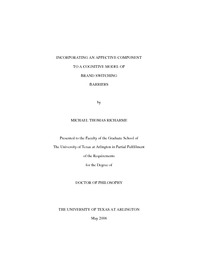
ATTENTION: The works hosted here are being migrated to a new repository that will consolidate resources, improve discoverability, and better show UTA's research impact on the global community. We will update authors as the migration progresses. Please see MavMatrix for more information.
Show simple item record
| dc.contributor.author | Richarme, Michael Thomas | en_US |
| dc.date.accessioned | 2007-08-23T01:56:42Z | |
| dc.date.available | 2007-08-23T01:56:42Z | |
| dc.date.issued | 2007-08-23T01:56:42Z | |
| dc.date.submitted | April 2006 | en_US |
| dc.identifier.other | DISS-1231 | en_US |
| dc.identifier.uri | http://hdl.handle.net/10106/421 | |
| dc.description.abstract | Customer retention is an important goal of business. It has been shown in a general model of brand switching that consumers utilize internal assessments of satisfaction and brand switching barriers to reach brand selection decisions.
Satisfaction is a complex construct, and has been studied extensively for the past several decades. However, this construct only accounts for approximately a quarter of explained variance in the customer retention construct.
Brand switching barriers have not been studied extensively, though they have recently been shown to account for up to 30 percent of variance in the same dependent construct. Thus, a better understanding of brand switching barriers can yield important insights into consumer decision processes and has significant strategic implications relative to customer retention.
This general model of brand switching conceptualizes the underlying decision-making activity as quantitative, precise, and machine-like. Recently, advances in the examination of decision-making have shown affect to play a role in the evaluation of alternatives. In marketing, affect can be seen at a higher level in the moderating constructs of consideration and involvement. The purpose of this dissertation is to incorporate an affect component in the general model of switching barriers and customer retention.
Utilizing a two-wave, matched sample survey of approximately 1200 cellular telephone service consumers, data have been collected for the above constructs. Primary analysis consists of developing a structural equation model to evaluate the main effects of both the newly introduced affect construct and the replicated brand switching barrier and customer satisfaction constructs, as well as the covarying relationships of each of these constructs.
The four major constructs in the model, Customer Retention, Brand Switching Barriers, Satisfaction, and Affect, are found to be reliable and discriminating constructs. The independent construct, Retention, was asked of respondents in three different manners, and the results were internally consistent across question modes. With a longitudinal matched sample across four months, actual behavior was compared to stated intention and found to be consistent as well. | en_US |
| dc.description.sponsorship | Munch, James | en_US |
| dc.language.iso | EN | en_US |
| dc.publisher | Marketing | en_US |
| dc.title | Incorporating An Affective Component To A Cognitive Model Of Brand Switching Barriers | en_US |
| dc.type | Ph.D. | en_US |
| dc.contributor.committeeChair | Munch, James | en_US |
| dc.degree.department | Marketing | en_US |
| dc.degree.discipline | Marketing | en_US |
| dc.degree.grantor | University of Texas at Arlington | en_US |
| dc.degree.level | doctoral | en_US |
| dc.degree.name | Ph.D. | en_US |
Files in this item
- Name:
- umi-uta-1231.pdf
- Size:
- 1.653Mb
- Format:
- PDF
This item appears in the following Collection(s)
Show simple item record


